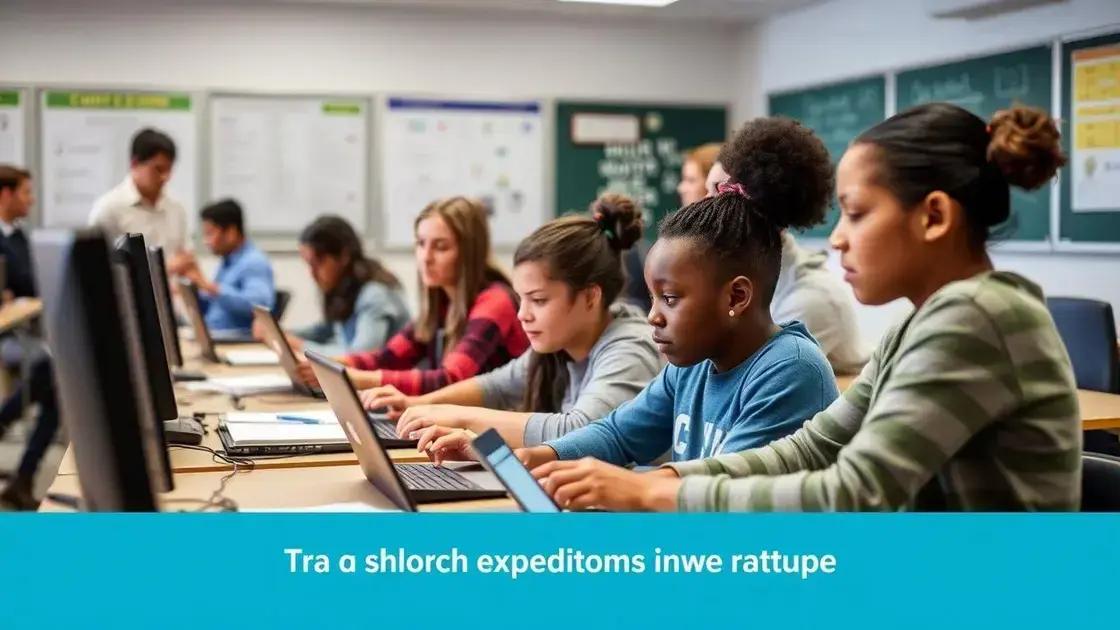Teacher workforce challenges: understanding Trump’s tariff exemptions

Anúncios
Addressing teacher workforce challenges involves implementing effective strategies like fostering a supportive environment, investing in professional development, and promoting work-life balance to enhance teacher retention and satisfaction.
When discussing teacher workforce challenges, it’s crucial to consider how policies affect education. With Trump’s recent tariff exemptions for Chinese-made iPhones, educators may face new hurdles, especially in technology access. Curious about the broader implications? Let’s dive in.
Anúncios
Current challenges in the teacher workforce
The current challenges in the teacher workforce have become a significant topic in education discussions. Teachers face numerous hurdles that impact their roles and effectiveness in the classroom. Understanding these challenges is essential for improving the educational landscape.
High Turnover Rates
One major challenge is the high turnover rates among teachers. Many educators leave the profession within the first few years due to factors like inadequate support and low pay. It’s crucial to address these reasons to retain experienced professionals.
Anúncios
- Inadequate support from administration
- Low salaries compared to other professions
- Increased workloads and stress
- Lack of career advancement opportunities
Another issue affecting teachers is the lack of resources. Many classrooms are underfunded and lack the necessary materials for effective teaching. This shortage makes it difficult for teachers to provide quality education.
Impact of Technology
With the rapid evolution of technology, teachers must stay updated with new tools. This requirement can add to their workload. Professional development programs are essential to equip them with the skills needed. However, access to these programs can be limited, creating further challenges.
Furthermore, classroom management continues to be a significant issue. As student behaviors evolve, teachers often find themselves unprepared to handle classroom disruptions. Strategies and training in effective classroom management are vital for creating a conducive learning environment.
By acknowledging and addressing these current challenges, we can support teachers better and improve education overall. Enhancing pay, providing more resources, and investing in professional development are steps in the right direction.
Impact of tariffs on educational technology
The impact of tariffs on educational technology is a critical issue for schools and teachers today. With escalating tensions in trade policies, schools are feeling the pressure as costs for essential technology rise. Understanding this impact helps us see how it affects classrooms.
Rising Costs for Schools
As tariffs on imported technology increase, schools face higher expenses. This rise in costs can lead to tough decisions about budgeting for new devices. Many institutions may have to limit their purchases, affecting the availability of modern tools necessary for teaching.
- Reduced access to computers and tablets
- Higher prices for educational software
- Limitations on innovative educational programs
- Increased burden on school budgets
Moreover, these tariffs can slow down the adoption of innovative technologies. Schools aim to prepare students for a tech-driven future, but rising prices can hinder their ability to invest in essential digital resources.
Effects on Teaching and Learning
Access to up-to-date technology is vital for modern teaching methods. Without the latest tools, teachers struggle to keep lessons engaging and relevant. The lack of technology can impact students’ learning experiences directly. They may miss out on critical skills needed for the workforce.
Furthermore, educational equity suffers as some districts may not afford these technologies. This disparity hinders students in less affluent areas while well-funded schools thrive. Addressing the impact of tariffs on educational technology is crucial to ensure fair opportunities for all students.
In summary, the consequences of tariffs on technology in education are vast. Schools must navigate these challenges to provide the best possible learning environments for their students.
Case study: Chinese-made iPhones in schools

The case study of Chinese-made iPhones in schools provides insight into how technology influences education. With the rise of mobile devices, many schools began integrating iPhones into their teaching methods. This integration offers numerous learning opportunities but also presents challenges.
Integration in the Classroom
Using iPhones in classrooms enhances student engagement. Teachers utilize apps for interactive lessons, making learning more dynamic. Students can access information quickly and collaborate through various platforms.
- Increased access to educational resources
- Enhancement of communication between students and teachers
- Facilitation of group projects and presentations
- Improvement in digital literacy skills
However, there are concerns about distractions. While iPhones can aid learning, they can also divert attention to non-educational content. Teachers must find a balance to maximize their benefits while minimizing distractions.
Budget Considerations
Another aspect of this case study is the financial impact of incorporating Chinese-made iPhones in schools. While cost-effective, the initial investment can be high. Schools often face budget constraints, making it challenging to provide devices for all students.
Moreover, the ongoing maintenance and upgrade costs can strain school budgets. School districts need to consider these factors when deciding to deploy technology. Ensuring every student has access to the same resources is crucial for equitable education.
In summary, examining the integration of Chinese-made iPhones in schools reveals both exciting possibilities and practical challenges. The focus remains on how to use this technology effectively while addressing its potential drawbacks. Schools must continually evaluate the impact of these devices to ensure they serve educational goals well.
Future trends in teacher workforce management
Understanding the future trends in teacher workforce management is essential for creating effective educational environments. As society evolves, so do the needs and expectations of both teachers and students. This section explores how these trends shape the teaching profession.
Emphasis on Retention Strategies
One significant trend is the growing emphasis on retention strategies to keep teachers in the profession. Many districts are now focusing on enhancing job satisfaction through better support systems. This includes offering mentorship programs for new teachers and providing professional development opportunities.
- Development of mentorship programs
- Regular training sessions for skills enhancement
- Recognition and rewards for teacher achievements
- Improvement of work-life balance practices
With these strategies, schools aim to reduce turnover rates and create a stable learning environment. Happy teachers often lead to happy students, ultimately benefiting the entire school community.
Increased Use of Technology
Another trend is the increased use of technology in workforce management. Schools are utilizing data analytics to track teacher performance and identify areas needing support. This technology-driven approach allows for more personalized interventions, helping teachers thrive in their roles.
Additionally, online platforms facilitate communication between administration and staff. Having access to necessary resources at their fingertips empowers teachers to perform better. Technology is also crucial in facilitating remote professional development opportunities for busy educators.
Moreover, there is a strong push for diversity and inclusion within the teacher workforce. Educational institutions are recognizing the importance of having diverse perspectives in classrooms. This change requires targeted recruitment and hiring practices that promote a more inclusive workplace.
As we look to the future of teacher workforce management, understanding these trends will help create an environment where both educators and students can thrive. Schools must adapt to changing landscapes to ensure they meet the needs of today’s learners.
Recommendations for navigating workforce issues
To effectively address workforce issues in education, implementing practical recommendations is essential. These strategies offer guidance for school administrators and policymakers to enhance teacher satisfaction and retention.
Fostering a Supportive Environment
Creating a supportive work environment is key. Schools should encourage open communication where teachers feel safe sharing their concerns. This approach builds trust and open dialogue between teachers and administration.
- Regular feedback sessions with staff
- Opportunities for peer mentoring
- Acknowledgment of teacher achievements
- Access to counseling and mental health resources
Support from administration fosters job satisfaction. When teachers feel valued, they are more likely to stay in their positions long-term. Providing avenues for professional growth is another vital aspect.
Investing in Professional Development
Investing in ongoing training and professional development is critical for keeping educators engaged. Schools should offer workshops and seminars tailored to their needs. This investment empowers teachers to evolve in their roles.
Additionally, creating pathways for leadership can motivate teachers. By allowing experienced educators to take on mentorship roles or administrative tasks, schools can build a stronger leadership pipeline. Such opportunities enhance both teacher morale and student experiences.
Furthermore, schools should prioritize work-life balance to combat burnout. Flexible scheduling and promoting self-care can significantly reduce stress. Encouraging teachers to maintain a healthy work-life balance leads to a more productive workforce.
In conclusion, navigating workforce issues requires proactive strategies that prioritize teacher support and growth. By fostering an environment that values educators and their contributions, schools can create a positive impact on education.
FAQ – Frequently Asked Questions about Teacher Workforce Management
What are the main challenges faced by teachers today?
Teachers face challenges like high turnover rates, lack of resources, and increased workloads, affecting their job satisfaction.
How can schools improve teacher retention?
Schools can improve retention by providing mentorship programs, professional development, and recognizing teacher achievements.
Why is professional development important for teachers?
Professional development helps teachers build skills, stay updated with teaching methods, and boosts their confidence in the classroom.
What role does work-life balance play in teacher effectiveness?
Promoting work-life balance helps reduce teacher burnout, leading to more effective teaching and a positive classroom environment.






